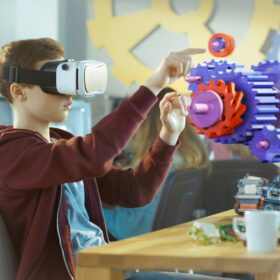Why Technology Doesn’t Mean Better Learning

Should students use technology when learning? Parents often ask why Oxford Learning students don’t use tablets or computers to complete their workbooks in class. With the rise of technology such as AI, this question is more than valid. After all, today’s students are digital natives, fluent in all things tech.
Technology has made many exciting advances in learning that can simplify students’ learning experience and make it more interactive and engaging. AI, ChatGPT, learning apps, and voice-to-text notetakers are just some of the tools readily available to students of all ages.
But does using technology lead to better learning?
Many believe that technology is the education tool of the future, simplifying how students access information, collaborate with other students, and store information. Undoubtedly, knowing how to use technology properly is vital for students of all ages.
However, research shows that using technology to learn can be more of a hindrance than a help, especially when building basic learning skills.
Offline Learning Vs Online Technology Learning
When it comes to building basic learning skills in the Rs, what impact does tech have?
READING
When reading for school, is it better to read from screens vs reading from paper? What we know is that the brain processes digital reading differently than it does when reading from paper. Online screens are never still. There are always links present, waiting to distract and bring our attention elsewhere.
Studies examined the connection between how the eyes and brain process information when reading from a screen vs reading off paper. The research showed that reading and writing on paper helps students encode information more effectively and thus store it or retrieve it from their memories more effectively.
Reading online leads to shallower processing and less memory retention, whereas reading on paper leads to deep reading. On paper, the text itself provides a “landscape” as we read that helps the memory centre become more active. Paper reading activates multiple senses, including touch and sound, activating more brain areas. Information is processed more effectively when students use multiple senses simultaneously. On the other hand, online reading can lead to shallow reading that isn’t encoded effectively.
WRITING
Much like reading from paper, writing by hand activates more brain areas than typing on a keyboard. When we write by hand, we have to think about the formation of each letter and the words we are writing, which requires more mental effort than typing. Research suggests that handwriting can help with memory retention and creativity.
Writing notes in class involves several processes:
- Listening to what the teacher says.
- Deciding what to write down and emphasize.
- Connecting that information to prior knowledge.
This is known as the “process function” of note-taking, meaning students must process what they are writing. When students take notes with a laptop or a note-taking app, they get the “product function.” In other words, they get great notes they don’t have to think about.
According to the research, handwritten class notes are also better for capturing concepts and ideas.
ARITHMETIC
The goal of learning math is to develop an understanding of how numbers work and to be able to perform mental math without the help of a calculator. Relying on technology to solve formulas or practice key skills doesn’t help students build a true understanding of math principles and can even lead to math anxiety.
Building the basics of math requires numeracy—aka math literacy—often built with hands-on practice and learning exercises to build speed, accuracy, and mastery. A strong understanding of math’s basic concepts is needed before moving on.
Hands-On Math Learning
Math understanding requires deep thinking about numbers, noticing patterns in how numbers work together, and making connections. Manipulatives allow students to group, arrange, connect, integrate, and build a visual connection to theoretical math concepts. When young children use manipulatives, aka physical objects like blocks, to represent math facts, they engage with math concepts physically, using more senses and building a deeper understanding.
Other Tech Issues to Consider
Health & Well-Being
Whether it’s for learning or leisure, too much screen time for children can be linked to many challenges, such as interfering with sleep habits, decreasing attention, and even reducing memory. It can also affect student mental well-being.
Increased screen time can also lead to brain changes in young children: higher screen use negatively affects up to 56% of the brain areas dealing with language, literacy, imagination, and executive function, such as self-regulation. source
Traditional Learning with Oxford Learning
Technology has many benefits in learning, such as accessing information, collaboration, and engagement. Online learning tools are always available and accessible and meet students’ needs at the surface level. Today’s children are digital natives, which means that computers have always been part of their daily lives, and screen time is part of both their education and recreation; it’s natural to think that learning that doesn’t use technology seems old-fashioned. However, the opposite is true.
The more students use technology to learn, the more important and necessary the in-person, one-on-one connection-based instruction model becomes.
Oxford Learning classes focus on delivering a personalized learning experience, building connections with students, and helping them understand that they can achieve their goals. Classes end with high fives and smiles, and that is something that no app, tech, or AI will ever be able to deliver.



